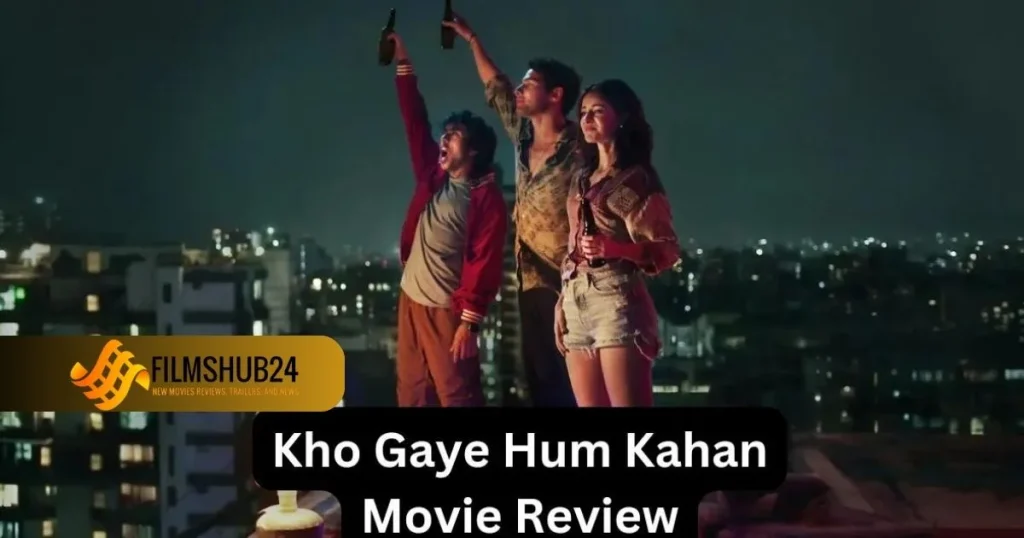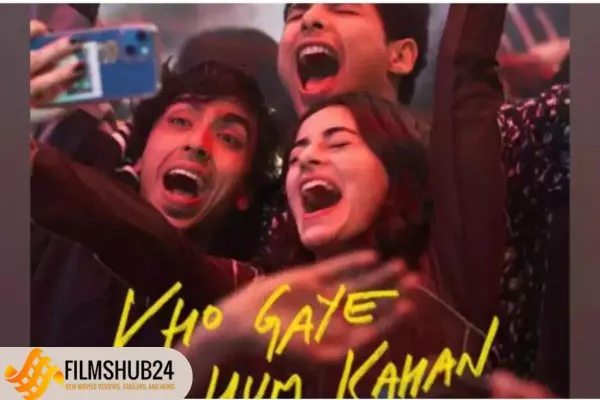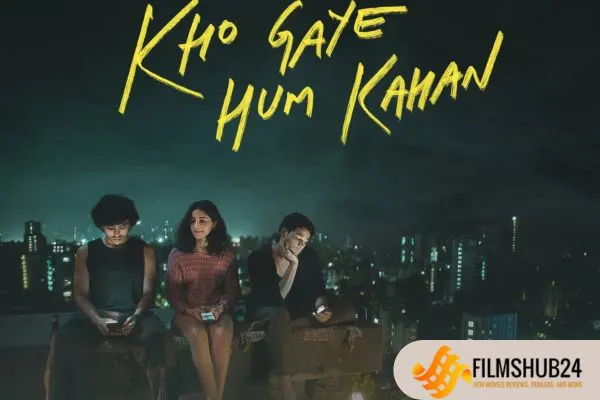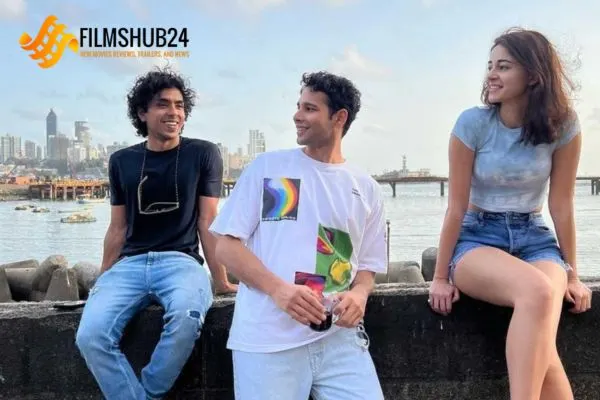
Set in a time of social media relationships, the song is a contemporary take on the loss of face-to-face communication. Produced by the dynamic trio Zoya Akhtar, Reema Kagti, and Farhan Akhtar, the Arjun Singh directorial charts a coming-of-age tale of friendship, self-discovery, and the overwhelming presence of technology in our lives.
We are going to reviewKho Gaye Hum Kahan, focusing on its story, performances, concept, and execution.
Plot Overview Kho Gaye Hum Kahan Movie Review at filmshub24
About Kho Gaye Hum Kahan, Kho Gaye Hum Kahan follows the everyday journey of three millennial friends, Siddhant Chaturvedi, Ananya Panday, and Adarsh Gourav, through the whirlwind complexities of Mumbai city life. It tracks their relationship, molded and tested by the digital world surrounding them.
Technology, despite making our lives convenient and immediately connected can also alienate people from one another, a theme that the movie deals with. Under The Trees takes readers inside the minds and hearts of a group of friends, all of who are in their early twenties, as they grapple with personal and professional dilemmas threatening to tear them — even further — apart from one another in a hyper-paced screen-filled society.
Quick to be pegged as a pilot to another travel-rom-com, Kho Gaye Hum Kahan is more about loneliness, identity, and the mean business of real-life connections when everything else is digital.
Performances

One of the stronger points for Kho Gaye Hum Kahan is the performance.
Siddhant Chaturvedi flashes his breakout Gully Boy smile and steps into the shoes of a young professional, dealing with questions of success, complacency, and self-worth. This is the new person, forever touting the traditional propagation of personal inspiration with emotional entanglement. Chaturvedi portrayal of vulnerability is what kept the job so engaging.
Ananya Panday is a social media influencer who is popular online but has some personal insecurities. This lends a layer of depth to her character and you feel her conflict starting to show when she talks about the accident. She shares easy chemistry with Chaturvedi, which makes the friendship on screen seem real.
Coming hot off of his critically lauded work in The White Tiger, Adarsh Gourav provides a sensibility that grounds the character within the film. The character embodies a common bond between the three, and his performance is suitably unflashy but crucial as it provides the list of emotions core of the story.
Each of the three actors provides a certain part, making it feel true to life and reflecting the way friendships come and go over time, full of highs and lows but always ending in forgiveness.
Direction and Screenplay
This subject is handled with such sensitivity by the first-time director Arjun Varain Singh, and needless to say, he has done a fine job. Singh walks that line well and keeps some levity in between the raw emotional moment. He conveys the late-millennial experience — overworked, underpaid, tired, and tired out of real intimacy — in a voice that is honest without feeling like a sermon.
The best part of the film is its screenplay written by Zoya Akhtar, Reema Kagti, and Arjun Varain Singh which is terrific. It mangles the digital and emotional with laser precision across the lives of its characters. Someone in their early 20s now talks the way those characters talk, so I think there will be an extra little layer of verisimilitude.
The film has a trundling momentum and an adequate runtime for its plot. It has no superfluous subplots, no distractions away from the way these characters and their types of relationship evolve, or whatever other excuses you could claim to make up for my all but casino-betting-being-a-certainly born-in-bed-twat.
Cinematography and Music

Kho Gaye Hum Kahan is more of a visual storytelling. Avik Mukhopadhyay also does well in bringing Mumbai to life — a cinematographer who has captured the chaotic and vibrant essence of its urban landscape. The city is not only the setting but a character in its own right, representing the frenetic pace of millennial existence.
The film is fascinating in how it treats technology as a canvas. The screens (whether the iPhone on which Mazurov nudges and swipes, the computer on which Dasha come-ons without being there, or our social media feeds) function as a massive testament to how difficult it is to write teens in general and kids of this generation specifically.
The music — composed by Ankur Tewari is in complete sync with the mood of the film. Those numbers are all pretty light while remaining evocative and seem to fit well into the musical framework without overshadowing it. The title song, “Kho Gaye Hum Kahan,” which reverberates the sentiment of getting lost amidst digital clutter is one of the defining tracks of the label.
Themes and Social Commentary
Kho Gaye Hum Kahan at its heart is about disconnectivity in an over-connected world. It critiques the digital age and how, while it may help connect people to all corners of the world, results in emotional isolation.
The film can also strike a chord with those from a time that is always striving for the ‘perfect’ life on social media. The film investigates the emptiness that comes from chasing virtual validation through its characters and also stresses the necessity of real-life offline relationships.
It is subtly wicked in how we constantly mirror our mere lives to one another’s highlight reel and, through doing so may slowly strip us of any hint self self-worth or confidence, at the same time highlighting a facet of mental health. These concerns are exacerbated in today’s social media-obsessed society, making Kho Gaye Hum Kahan a film less and more like the timescale of the modern day.
Strengths and Weaknesses
Strengths:

Authentic Performances — The cast gives natural, plausible performances that ground their characters in reality.
Relevant Themes: The movie is very relevant and this comes across as they dive deeper into the world of social media and relationship impact.
Direction & Screenplay:The sharp screenplay by Arjun Varain Singh along with his enigmatic direction keeps you hooked right from the word go.
CINEMATOGRAPHY — The movie is shot in such an aesthetical manner and the urban landscape of Mumbai plays a perfect battleground for this tale.
Weaknesses:
Things to Know: As interesting as the movie is, there’s a certain predictability in its plot of how it will resolve its central conflict.
Side Characters Are Lightly Fleshed Out: While the three primary players receive decent attention, a few of the supporting characters could have used additional love.
Ratings
Storyline: 8/10
Performances: 8.5/10
Direction: 8/10
Cinematography:8/10
Music: 7.5/10
Overall Rating: 8/10
Final Verdict
Kho Gaye Hum Kahan is a novel take on the very zoned-out friendships of millennials lost in the digital era. This time the movie has performances, especially by Siddhant Chaturvedi, Ananya Panday, and Adarsh Gourav that create an emotional connection with viewers. Arjun Varain Singh has handled this subject confidently, and what makes the Watcher a good watch is that it feels completely relevant to the times we live in; where our personalities can easily be shaped by the consumption of so many versions of truth.
